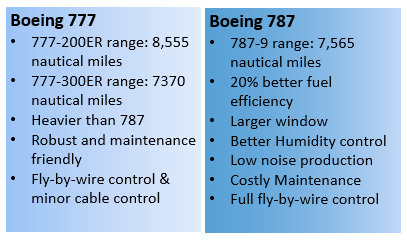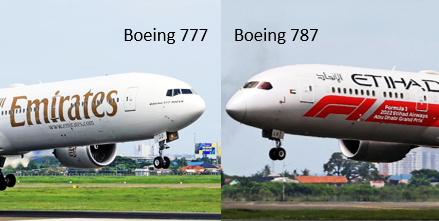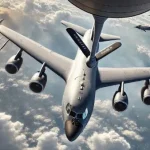When it comes to long-haul air travel, Boeing’s 777 and 787 aircraft represent two of the manufacturer’s most advanced and popular options. Both are designed for efficient, long-distance flights, but they cater to different needs and preferences within the aviation industry. In this article, we’ll explore and compare various aspects of these two iconic aircraft.
Design and Development

Boeing 777: Launched in 1995, the Boeing 777 was Boeing’s inaugural all-digital fly-by-wire aircraft and the first to be fully designed using computer-aided design (CAD) technology. The aircraft was engineered to transport a substantial number of passengers across long distances while maintaining a track record of reliable performance. The 777 is known for its distinctive, massive engines and wide wingspan, which contribute to its high performance and efficiency.
Boeing 787: The Boeing 787 Dreamliner, introduced in 2009, represents a significant leap in aircraft technology. It incorporates advanced materials, including carbon-fiber-reinforced polymer, which reduces weight and enhances fuel efficiency. The 787’s design emphasizes passenger comfort and operational efficiency, featuring larger windows and a quieter cabin environment.
Size and Capacity

Boeing 777: The 777 family includes several variants, such as the 777-200, 777-200ER, 777-300, and 777-300ER. The largest variant, the 777-300ER, has a wingspan of about 212 feet 7 inch and can typically accommodate 368 to 451 passengers, depending on the seating configuration. It is known for its high passenger capacity and long range.
Boeing 787: The 787 also comes in three main variants: the 787-8, 787-9, and 787-10. The 787-9, the most popular variant, has a wingspan of approximately 197 feet and generally seats around 242 to 290 passengers. The 787’s focus is on a balance between capacity and fuel efficiency, making it suitable for various route lengths and passenger loads.
Performance and Efficiency

Boeing 777: The 777’s performance is characterized by its powerful engines, such as the GE90 and the Trent 800 series. These engines, coupled with its large wingspan, provide excellent fuel efficiency for an aircraft of its size. The 777-200ER has a range of approximately 8,555 nautical miles, while the 777-300ER can fly up to 7370 nautical miles as well, making it suitable for ultra-long-haul routes.
Boeing 787: The 787 Dreamliner boasts impressive fuel efficiency due to its advanced materials and more modern engines, like the GEnx and Trent 1000. The 787-9, for example, offers a range of around 7,565 nautical miles, which is slightly shorter than the 777 but still sufficient for most long-haul flights. The 787’s design results in about 20% better fuel efficiency compared to similarly sized older aircraft.
Passenger Experience
Boeing 777: The 777 is renowned for its spacious cabins and high levels of comfort, especially in its newer variants. Airlines often configure the cabin with a 3-3-3 seating arrangement in Economy class, which enhances passenger comfort. However, the cabin environment can vary significantly based on airline specifications and interior choices.
Boeing 787: The 787 Dreamliner places a strong emphasis on passenger comfort. Features like larger windows with electronic dimming, improved cabin altitude, and better humidity levels contribute to a more pleasant flying experience. The 787’s quieter cabin and reduced jet lag effects are also significant improvements over older aircraft models.
Technological Advancements
Boeing 777: The 777 was a major leap forward in terms of avionics and fly-by-wire technology at the time of its introduction. It includes advanced systems for navigation and flight management, though its technology is now somewhat dated compared to newer models.
Boeing 787: The 787 Dreamliner incorporates state-of-the-art technology, including the latest avionics and flight control systems. Its use of composite materials and advanced aerodynamics represents a significant technological advancement over the 777. Additionally, the 787’s systems are designed for greater efficiency and lower maintenance costs.
Operational Costs and Maintenance
Boeing 777: The operational costs for the 777 are relatively high due to its size and the complexity of its systems. However, it is a proven workhorse for airlines, with a strong track record of reliability. Maintenance costs can be substantial, though they are mitigated by the aircraft’s extensive service history and support network.
Boeing 787: The 787’s use of composite materials and newer technology translates to lower operational costs and maintenance requirements compared to older aircraft like the 777. Its improved fuel efficiency is incomparable with that of other legacy Boeing aircraft. However, according to the MROs, the maintenance cost is higher than for B777 aircraft.
This may be due to new technology and lack of expertise in this modern more electric aircraft and we hope that by the time being Boeing will be able to improve their component and maintenance engineers or technicians will be able to find out their best techniques to minimize the maintenance cost.
Environmental Benefits of the Boeing 787 Dreamliner
The Boeing 787 Dreamliner stands out for its impressive environmental and noise reduction features. It achieves 25% lower CO2 emissions compared to previous aircraft models, significantly contributing to reduced environmental impact.
In addition to exceeding regulatory standards for hydrocarbons, smoke, NOX, and CO, the 787’s design also ensures that community noise is effectively contained within airport boundaries.
This aircraft meets all current noise regulations and optimizes cabin acoustics, creating a quieter and more comfortable experience for passengers and minimizing disruption to surrounding communities.
Conclusion
Both the Boeing 777 and Boeing 787 offer unique advantages and cater to different segments of the market. The 777 is known for its high capacity and proven reliability, making it a favorite for ultra-long-haul flights and high-density routes. In contrast, the 787 Dreamliner represents the future of air travel with its focus on fuel efficiency, passenger comfort, and cutting-edge technology.
Ultimately, the choice between these two aircraft depends on the specific needs of airlines and their passengers. While the 777 continues to serve as a reliable and capable aircraft, the 787 offers a glimpse into the next generation of aviation, promising enhanced efficiency and comfort for years to come.



